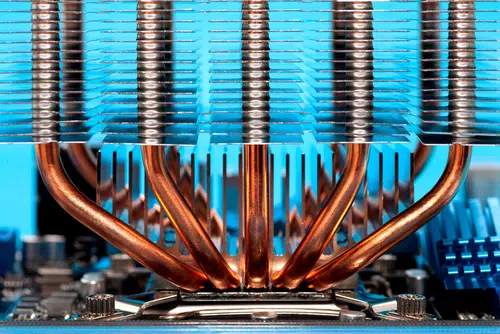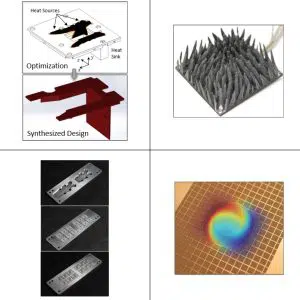Co-Authored by: Danny J. Lohan, Yuqing Zhou, and Ercan M. Dede
Toyota Research Institute of North America
INTRODUCTION
Generative design is an iterative design process that involves the use of a program to generate a set of optimized designs that meet product performance requirements and constraints. Methods that transform statements of performance requirements into product designs are also known as inverse design methods. Associated programs may involve feedback from a human designer or may be completely automated within a computer. Computer-based generative design may use artificial intelligence agents or numerical algorithms including rule-based and physics-driven techniques to generate designs that meet performance requirements. The optimized designs often involve, but are not limited to, product size, shape, or topology, as well as, material and process selection.
The explosion of computing power, discoveries of novel materials, and advancement of manufacturing methods have sparked great excitement over the potential of generative design. New materials (e.g., phase-change polymers) have enabled new product functionalities, and advanced manufacturing processes (e.g., 3D printing) can now make parts we could not imagine manufacturing before. Taking advantage of today’s ubiquitous and extremely fast computing power, generative design produces spatially novel yet efficient product designs that can be realized with state-of-the-art materials and manufacturing process capabilities. Today, generative design is not only regarded as an effective tool to reformulate components but an innovative platform to revolutionize product research, development, and design across industries. In this issue and article, the implementation of generative design for electronics cooling applications is discussed.
BIOLOGICALLY INSPIRED DESIGN OF THERMAL CONDUCTORS
In this section, a representative example of how to exploit generative design for a heat transfer (source-to-sink, thermal conductor) application is presented, as explained in detail. This process includes: 1) identifying a target design space (what type of structure you want to generate); 2) selecting an appropriate design representation (what generative algorithm you wish to use to produce a structure); and 3) utilizing physics-based simulation in an optimization loop to obtain the best performing structure.
Researchers have demonstrated the performance benefits of branching and finned structures for heat transfer applications; see Fig. 1 for examples. Nature has spent millions of years fine-tuning the performance of natural branching structures for their respective functions. Using application-relevant observations, design engineers can extract heuristics and embed them into generative design methods to provide an efficient and flexible optimization process. Furthermore, using generative methods, bioinspired characteristics may naturally emerge.
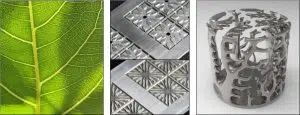
A survey of algorithms that generate branching structures was performed, including rule-based [4], interaction-based [5], and voxel-based [6] generative algorithms. The reader is referred to [1] for greater discussion of each approach. However, in particular, an interaction-based model called the space colonization algorithm [5], developed to quickly produce trees for computer graphics, was previously selected for further study because it provides a compact design representation (i.e., it requires few design variables), is computationally efficient to generate patterns (i.e., does so in a matter of seconds), and is capable of generating a wide variety of branching structures. The space colonization algorithm is a numerical adaptation of the canalization hypothesis [7], which suggests a theory to model the growth of leaf veins. A sketch of the algorithm is shown in Fig. 2. Growth hormone sources called auxins, blue circles, are first introduced onto the domain. Each auxin is paired to its nearest vein node, green circles, to influence its growth direction. The paired vein nodes will then proceed to grow in the average direction of its paired auxins. This process of pairing and growing repeats until all auxins have been reached. With this algorithm, the locations of the auxins are varied to search the design space.
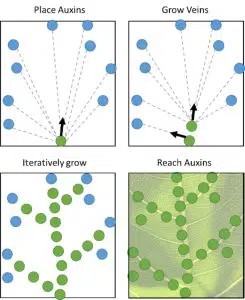
This generative algorithm was coupled with a heat conduction finite element simulation to determine the temperature distribution of the domain for the source-to-sink problem shown in Fig. 3. The design domain, Ω, uniformly generates heat, which can be extracted from a fixed temperature boundary, ΓD. The remaining boundaries, ΓN, are adiabatic and restrict heat flow within the domain. The goal of this optimization problem is to distribute thermally conductive material on the domain, Ω, to reduce the average temperature on the domain, given a limited budget of conductive material. A genetic algorithm was used to adjust the tuning parameters of the generative algorithm for the optimization routine.
The optimization results obtained using the interaction-based method were compared with a voxel-based algorithm for a simple heat conduction problem given 100 total thermal simulations; refer to Fig. 3. The voxel-based method generated a tree-structure with no prior assumption on form but spent a significant portion of time (50+ iterations) refining a more defined structure. The design obtained with the voxel-based method has a peak temperature of 445°C on the domain. The interaction-based generative algorithm, optimized using a genetic algorithm, searches a diverse set of branching structures to identify several well-performing designs. Of the 100 designs tested using the interaction-based algorithm, several dozen featured lower temperatures on the domain compared to the voxel-based design. The best design obtained using the interaction-based method has a maximum temperature of 292°C on the domain, which is a 34% improvement over the design obtained using the voxel-based method. Though both methods successfully produce designs that reduce the temperature of the domain, this example demonstrates how an improved search can be achieved when restricting the search space to a target class of structures. Carefully choosing an appropriate generative algorithm to represent a set target class of structures is one key to unlocking further improvements. The reader is referred to [1] for further details.
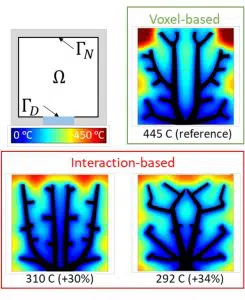
EXTENSIONS OF GENERATIVE DESIGN FOR ELECTRONICS COOLING
Generative design has been employed in a variety of applications related to electronics cooling. The design of thermal conductors by topology optimization has been explored relative to cooling an integrated circuit (IC) device in a power control unit [8]. Here, a designed prototype thermal conductor, Fig. 4a, was experimentally shown to provide reductions in the IC device maximum temperature of up to 60 C. Optimization of thermal conductors has been extended to include design-dependent loads in the form of conformal heat transfer coefficient boundary conditions with application to additively manufactured air-cooled heat sinks for electronics [9]. In this case, an optimized, fabricated, and experimentally tested pin fin heat sink structure, Fig. 4b, demonstrated the highest coefficient of performance when compared with similar surface area plate and pin fin heat sink layouts reported in the literature.
The consideration of fluid flow for conjugate heat transfer further enriches the generative design of heat sinks or cold plates for electronics cooling. This field has grown rapidly since the first work on topology optimization for thermal-fluid systems [10, 11]. The method has been successfully applied using a local-global (unit cell-manifold) design approach for liquid-cooled cold plates for power electronics [12]; refer to Fig. 4c. Interesting further applications include the design of heat sinks subject to natural convection for light emitting diode (LED) lamps [3], the design of manifold microchannel heat sinks for power electronics [13], and three-dimensional design of heat exchangers relevant to system-level electronics cooling solutions [14], to name just a few.
A somewhat distinct application of generative design for electronics cooling pertains to the optimization of thermal composites or thermal metamaterials. Here, the anisotropic material thermal conductivity of thermal composites in various forms may be exploited to route heat, Fig. 4d, and protect temperature-sensitive components from heat-generating devices [15, 16]. Interestingly, the same anisotropic thermal composite technology may also be leveraged in the scavenging or harvesting of waste heat [17].
CONCLUSION
This article introduced the concept of generative design as it relates to practical engineering for electronics cooling. To review, generative design is an iterative process where a program is used to create a set of designs that meet product requirements. This can be achieved using a design abstraction to enable the efficient creation and search of optimal structures. The increased capability of modern computing, coupled with advances in materials and manufacturing, have enabled generative design to become practical today.
A demonstrative example of using generative algorithms to design biologically inspired branching thermal conductors was outlined to articulate how such a process can be realized. This included identifying a target class of structures to search, choosing an appropriate generative algorithm to create the desired structure, and using physics-based simulation in an optimization routine to identify the best design. It was observed that choosing an appropriate generative algorithm provides an improved selection of optimal structures and motivates careful consideration of generative methods for a design task.
In addition to this case study, several examples of using generative design for electronics cooling were discussed. This included the design of thermal conductors in a power control unit and air-cooled heat sink, various conjugate heat transfer problems for liquid cold plates and heat exchangers, and metamaterial design for thermal insulation and energy harvesting applications. These examples represent a subset of ways generative design is being used today to enhance electronics cooling.
REFERENCES:
- D. J. Lohan, E.M. Dede, and J.T. Allison, Topology optimization for heat conduction using generative design algorithms. Structural and Multidisciplinary Optimization, 55, pp. 1063-1077 (2017).
- E. M. Dede and Y. Liu, Experimental and numerical investigation of a multi-pass branching microchannel heat sink. Applied Thermal Engineering, 55(1-2), pp. 51-60 (2013).
- J. Alexandersen, O. Sigmund, K. E. Meyer, and B. S. Lazarov, Design of passive coolers for light-emitting diode lamps using topology optimization. International Journal of Heat and Mass Transfer, 122, pp. 138-149 (2018).
- A. Bejan and S. Lorente, Constructal theory of generation of configuration in nature and engineering. Journal of Applied Physics, 100(4), p. 041301 (2006).
- A. Runions, B. Lane, and P. Prusinkiewicz, Modeling trees with a space colonization algorithm. In: Eurographics workshop on national phenomena, pp. 63–70 (2007).
- M. P. Bendsoe and O. Sigmund, Topology optimization – theory, methods, and application, 2nd edn. Springer (2004).
- T. Sachs, The control of the patterned differentiation of vascular tissues. Advances in Botanical Research, 9, pp. 151- 262 (1981).
- E. M. Dede, Y. Liu, S. N. Joshi, F. Zhou, D. J. Lohan, and J. Shin, Optimal design of three-dimensional heat flow structures for power electronics applications. ASME Journal of Thermal Science and Engineering Applications, 11(2), 021011 (2019).
- E. M. Dede, S. N. Joshi, and F. Zhou, Topology optimization, additive layer manufacturing, and experimental testing of an air-cooled heat sink. ASME Journal of Mechanical Design, 137(11), 111403 (2015).
- E. M. Dede, Multiphysics topology optimization of heat transfer and fluid flow systems. In: COMSOL Conference Boston, pp. 1-7 (2009).
- G. H. Yoon, Topological design of heat dissipating structure with forced convective heat transfer. Journal Mechanical Science and Technology, 24(6), pp. 1225-1233 (2010).
- E. M. Dede, Single-phase microchannel cold plate for hybrid vehicle electronics. In: Semiconductor Thermal Measurement and Management Symposium (SEMI-THERM), pp. 118-124 (2014).
- Y. Zhou, T. Nomura, and E. M. Dede, Topology optimization of manifold microchannel heat sinks. In: 19th IEEE Intersociety Conference on Thermal and Thermomechanical Phenomena in Electronic Systems (ITherm), pp. 740- 746 (2020).
- F. Feppon, G. Allaire, C. Dapogny, and P. Jolivet, Body-fitted topology optimization of 2D and 3D fluid-to-fluid heat exchangers. Computer Methods in Applied Mechanics and Engineering, 376, p. 113638 (2021).
- E. M. Dede, P. Schmalenberg, T. Nomura and M. Ishigaki, Design of anisotropic thermal conductivity in multilayer printed circuit boards. IEEE Transactions on Components, Packaging and Manufacturing Technology, 5(12), pp. 1763-1774 (2015).
- J. C. Kim, Z. Ren, A. Yuksel, E. M. Dede, P. R. Bandaru, D. Oh, and J. Lee, Recent advances in thermal metamaterials and their future applications for electronics packaging. ASME Journal of Electronic Packaging, 143(1), p. 010801 (2021).
- E. M. Dede, P. Schmalenberg, C.-M. Wang, F. Zhou, and T. Nomura, Collection of low-grade waste heat for enhanced energy harvesting. AIP Advances, 6, p. 055113 (2016)
About the authors:
Danny J. Lohan
Danny received his B.S. degree in general engineering, and his M.S. and Ph.D. in systems and entrepreneurial engineering from the University of Illinois at Urbana-Champaign. Currently, he is a scientist in the Electronics Research Department at the Toyota Research Institute of North America. His research interests include numerical design automation and multi-disciplinary design optimization for electrified systems.

Yuqing received the B.S. degree in mechanical engineering from Northeastern University, Shenyang, China, in 2012, and the M.S. and Ph.D. degrees in mechanical engineering from the University of Michigan, Ann Arbor, MI, USA, in 2014 and 2018, respectively. He is currently a Research Scientist with the Toyota Research Institute of North America. His research interest is design optimization of Multiphysics systems.

Ercan received the B.S. and Ph.D. degrees in mechanical engineering from the University of Michigan, Ann Arbor, MI, and the M.S. degree in mechanical engineering from Stanford University, Stanford, CA. He is the Group Manager of the Electronics Research Department at the Toyota Research Institute of North America. His team focuses on systems involving advanced sensors, power semiconductors, and electronics/photonics packaging. He has published over 100 articles on topics related to optimization of thermal, mechanical, and electromagnetic systems. He is one author of a book entitled Multiphysics Simulation: Electromechanical System Applications and Optimization. He holds 135 issued patents.
